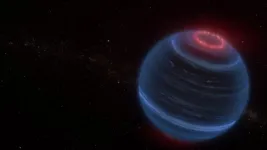(Press-News.org) JUPITER, Fla. — Like the Greek mythological beast with a snake’s tail and two ferocious heads, a potential Parkinson’s medicine created in the lab of chemist Matthew Disney, Ph.D., is also a type of chimera bearing two heads. One seeks out a key piece of Parkinson’s-causing RNA, while the other goads the cell to chop it to pieces for recycling.
The research is described in the Jan. 9 issue of the Proceedings of the National Academy of Sciences, or PNAS.
Parkinson’s is a frustrating and all too common disease. Slowly, people with Parkinson’s lose brain cells and other neurons needed to make the neurotransmitter dopamine. This progressive loss leads them to develop rigid, tense muscles and tremors, and causes difficulties with sleep, mood, speech, eating and movement.
Commonly used treatments include drugs that replace the dopamine. Other treatments, such as deep-brain stimulation, help with movement problems that develop as the disease worsens. But while these types of treatments alleviate symptoms, they are not a cure, come with side effects and do not change the trajectory of the disease. An estimated 500,000 people in the United States live with Parkinson’s.
“To change the course of this disease, we need to address its cause. For many Parkinson’s patients, that apparent cause is the accumulation of a toxic protein called alpha-synuclein, in and around their neurons,” said Disney, the endowed Institute Professor and chair of the chemistry department at The Herbert Wertheim UF Scripps Institute for Biomedical Innovation & Technology in Jupiter, Florida.
Unfortunately, alpha-synuclein has proven an especially challenging protein to medicate due to its unruly, disorganized form and lack of clear druggable structures, Disney added.
“In situations like this, we have found that targeting the RNA needed to build the toxic protein may be an optimal strategy to slowing or even stopping disease progression,” he added.
Disney’s lab focuses on interfering with or degrading RNA needed to assemble the proteins implicated in disease. This is a relatively new concept. Most drugs on the market work by binding to proteins to change their function. But not all disease-causing proteins can be successfully targeted with drugs. Some are too changeable, some lack druggable structures, some fold in a way that conceals their active sites.
Disney’s approach is to prevent the problematic proteins from being made in the first place. To do that requires targeting their RNA. Here’s why: Proteins are assembled in cells through a process that involves the reading and translation of a gene, the transport of that information from the cell nucleus to its cytoplasm via messenger RNA, and the assembly of protein-building factories called ribosomes, also built of RNA, in the cytoplasm. The ribosomes stitch the proteins together one amino acid at a time. Disney’s potential Parkinson’s drug, which he calls Syn-RiboTAC, binds to a section of messenger RNA that tells a ribosome to start protein assembly. Without the “start” signal, the toxic protein isn’t built.
Disney’s first authors on the PNAS study were graduate students in his lab. Yuquan Tong is a current student of the Skaggs Graduate School of Chemical and Biological Sciences on the Jupiter, Florida campus, and Peiyuan Zhang, Ph.D., is a recent graduate, now a postdoctoral researcher at the Massachusetts Institute of Technology.
“In Parkinson’s mouse models, we see that reducing alpha-synuclein by even 25% is therapeutically beneficial,” Tong said. “In studies from induced neurons of Parkinson’s patients, we see the Syn-RiboTAC strategy reduces alpha-synuclein production by about 50%. We saw that adding the RiboTAC produces a significant gain in potency.”
Disney added that the compound also showed good selectivity, important for avoiding unwanted side effects, and improved brain-barrier penetration relative to other compounds they studied.
Other collaborators on the study included physician-scientist M. Maral Mouradian, M.D., of Rutgers University, whose patients donated tissue to create induced neurons.
Much work lies ahead, as the team works to refine the two-headed drug and improve its drug-like properties, the scientists said. Preparing an experimental compound for clinical trials in humans can sometimes take years, as refinements are made and data are gathered.
“The medical need for a truly disease-modifying treatment is significant, and we know that patients are awaiting better options,” Disney said. “We’re hopeful that we’re on the road to a better days for people living with Parkinson’s.”
END
Inspired by Greek mythology, this potential drug shows promise for vanquishing Parkinson’s RNA in early studies
2024-01-09
ELSE PRESS RELEASES FROM THIS DATE:
Plant warfare: the crucial function of Nrc proteins in tomato defense mechanisms
2024-01-09
In the fascinating world of plant biology, an innovative study recently featured on the cover of The Plant Journal has been turning heads. The research delves into the intricate defense mechanisms of tomatoes against the notorious bacterial pathogen, Pseudomonas syringae pv. tomato (Pst). It's a classic tale of nature's arms race: as pathogens evolve to outsmart plant defenses, plants counter with more sophisticated immune responses.
The study is based on research conducted by scientists in Dr. Greg Martin’s lab ...
NASA’s Webb finds signs of possible aurorae on isolated brown dwarf
2024-01-09
Astronomers using NASA’s James Webb Space Telescope have found a brown dwarf (an object more massive than Jupiter but smaller than a star) with infrared emission from methane, likely due to energy in its upper atmosphere. This is an unexpected discovery because the brown dwarf, W1935, is cold and lacks a host star; therefore, there is no obvious source for the upper atmosphere energy. The team speculates that the methane emission may be due to processes generating aurorae.
These findings are being presented at the 243rd meeting of the American Astronomical Society in New Orleans.
To help explain the mystery of the infrared ...
Meagan Brem and team receive grant to study alcohol-fueled acts of violence among intimate partners
2024-01-09
Beer pong. Quarters. Flip cup. The drinking games college students play can seem like an alcohol-laced version of intramural sports.
When college-aged drinkers imbibe too heavily, the risk for physically harming a romantic partner rises considerably.
What if there was a way for heavy drinkers to monitor their alcoholic intake and blood-alcohol levels in real time, before an intimate situation cascades into physical violence?
Or, as Virginia Tech researcher and assistant professor of psychology Meagan Brem put it: “If we can identify ...
Unlocking the secrets of a "hot Saturn" and its spotted star
2024-01-09
Led by researchers from Université de Montréal's Trottier Institute for Research on Exoplanets (iREx), a team of astronomers has harnessed the power of the revolutionary James Webb Space Webb Telescope (JWST) to study the "hot Saturn" exoplanet HAT-P-18 b.
Their findings, published last month in the journal Monthly Notices of the Royal Astronomical Society, paint a complete picture of the HAT-P-18 b's atmosphere while exploring the great challenge of distinguishing its atmospheric signals from the activity of its star.
HAT-P-18 b is located over 500 light-years away ...
RSV shown to infect nerve cells, cause inflammation and damage
2024-01-09
Respiratory syncytial virus (RSV), a common infection in children and senior adults, can also infect nerve cells and trigger inflammation leading to nerve damage, according to a new Tulane University study.
RSV can cause mild symptoms such as coughing, sneezing and fever or lead to more severe conditions such as pneumonia or bronchiolitis. But since the disease was first discovered in 1956, it has been thought to only infect the respiratory tract.
This study, published in The Journal of Infectious Diseases, is the first to prove that RSV can penetrate nerve cells and may provide the ...
A common marker of neurological diseases may play role in healthy brains
2024-01-09
https://www.ninds.nih.gov/news-events/press-releases/common-marker-neurological-diseases-may-play-role-healthy-brainsResearchers have discovered that a protein called phosphorylated α-synuclein, which is associated with several neurodegenerative diseases such as Parkinson’s disease and Lewy body dementia, is also involved in the normal processes of how neurons communicate with each other in a healthy brain. The research, published in Neuron, was funded in part by the National Institute of Neurological Disorders and Stroke (NINDS), a part of the National Institutes of Health.
Phosphorylation is a process where a phosphate ...
ChatGPT poem regurgitation raises ethical questions
2024-01-09
ITHACA, N.Y. – Ask ChatGPT to find a well-known poem and it will probably regurgitate the entire text verbatim – regardless of copyright law – according to a new study by Cornell University researchers.
The study showed that ChatGPT was capable of “memorizing” poems, especially famous ones commonly found online. The findings pose ethical questions about how ChatGPT and other proprietary artificial intelligence models are trained – likely using data scraped from the internet, researchers said.
“It’s generally not good for large language models to memorize large chunks of text, in part because it’s a privacy concern,” ...
Sickle cell raises COVID-19 risk, but vaccination lags
2024-01-09
Despite the fact that people with sickle cell disease have a much higher risk of serious illness or death if they develop COVID-19, a new study shows they’re also much less likely than those without sickle cell disease to have gotten vaccinated against coronavirus.
Completion of the initial COVID-19 vaccination series was nearly two times lower for adults with sickle cell disease as others their age, the analysis of data in Michigan shows.
In in teens and children over 5, who overall have lower rates of COVID-19 vaccination, those with sickle cell disease were far less likely than other young people to have gotten their doses by summer 2022, the analysis ...
Brookline Housing Authority partners with Hebrew SeniorLife for health and social services in senior housing
2024-01-09
The Brookline Housing Authority (BHA) has partnered with Hebrew SeniorLife, New England’s largest nonprofit provider of senior health care and living communities, and the only senior care organization affiliated with Harvard Medical School, to provide community life services including resident services, fitness, social programming, and nursing in BHA’s senior housing sites.
Hebrew SeniorLife brings to the BHA its model of housing with services called the Right Care, Right Place, Right Time (R3) program. This model uses a preventive approach to resident services, focused on one-on-one relationship building, community-wide ...
Sylvester-led research group unveils the first individual risk prediction model for multiple myeloma
2024-01-09
MIAMI, FLORIDA (EMBARGOED UNTIL JAN. 9, 2024 AT 4 PM EST) – A multicenter collaboration led by researchers at Sylvester Comprehensive Cancer Center at the University of Miami Miller School of Medicine has produced the first computational model for newly diagnosed multiple myeloma that predicts an individual’s personalized prognosis based on their tumor genomics and treatments.
The prediction model for individualized risk in newly diagnosed multiple myeloma, or IRMMa, improves on previous prognostic tools because it takes into account ...






